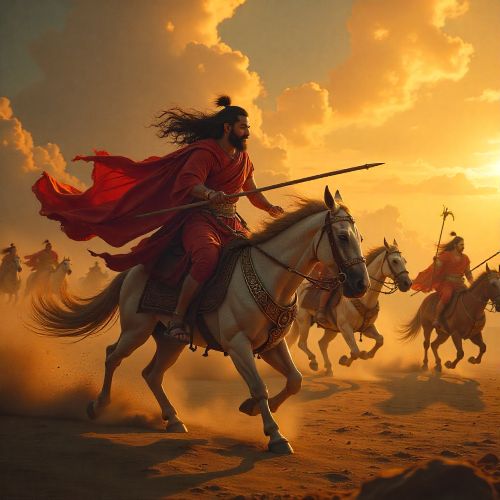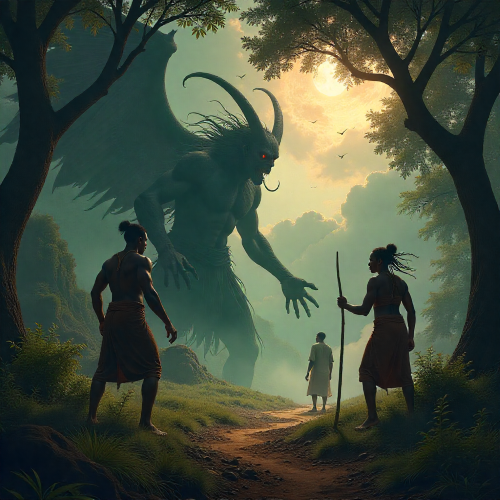Gandhari’s Curse : A Mother’s Fury and the Fall of a Dynasty
Listen
At a glance
| Description | |
|---|---|
| Mythology | Indian Mythology |
| Cursed Individual(s) | Krishna & Yadavas |
| Cursed By | Gandhari |
| Primary Consequence | Self-destruction of Yadava clan; Krishna’s lonely death |
| Symbolism | Impermanence of power, karmic justice, maternal grief |
Gandhari’s Curse
Introduction
In the Mahabharata—one of the greatest epics of Indian mythology—few moments carry as much emotional weight and philosophical depth as Gandhari’s curse. Pronounced at the end of the Kurukshetra War, the curse reflects a mother’s unbearable grief, a queen’s moral outrage, and the epic’s larger exploration of fate and cosmic balance. Gandhari’s curse is not simply a dramatic turning point; it is a profound illustration of how sorrow can transform into divine-charged speech capable of altering the destiny of gods and men alike. Even today, it stands as a powerful reminder of the consequences of conflict, leadership, and karmic justice.
Mythological Background
Gandhari, the princess of Gandhara, became queen of Hastinapura when she married Dhritarashtra, born blind and denied sight throughout his life. In a gesture of unwavering loyalty, Gandhari voluntarily blindfolded herself, choosing to share in her husband’s darkness rather than live with an advantage he did not possess. This decision shaped her identity as a woman of sacrifice and restraint. She later became the mother of one hundred sons—the Kauravas—whose rivalry with their cousins, the Pandavas, tore apart the Kuru dynasty. Gandhari’s life, bound by duty, devotion, and dharma, made her final pronouncement all the more emotionally potent and spiritually powerful.
Origin of the Curse
The curse originated in the aftermath of the Kurukshetra War, a conflict that lasted eighteen days but wiped out nearly the entire Kuru lineage. When Gandhari confronted Lord Krishna, who had guided the Pandavas and repeatedly attempted to prevent the war through peace negotiations, her anguish overcame her restraint. She accused Krishna of allowing the conflict to unfold despite his divine capacity to halt it. Consumed by grief at the loss of all her sons, she invoked a curse: just as she had witnessed the destruction of her lineage, Krishna would one day witness the destruction of his own. This moment captures the raw, human element of mythology—grief powerful enough to reshape cosmic destiny.
Nature of the Curse
Gandhari’s curse was not a spontaneous outburst but a spiritually charged decree uttered by a woman who had lived a life of austerity and righteousness. She declared that Krishna’s clan, the Yadavas, would destroy themselves in violence and chaos within thirty-six years. She further foretold Krishna’s own death: he would leave his kingdom behind, retire to the forest, and die alone, felled by a hunter’s arrow. Krishna accepted the curse calmly, acknowledging that it aligned with the cycle of cosmic time and marked the approaching end of the Dvapara Yuga. In this acceptance lies the philosophical core of the Mahabharata—that even the divine follows the laws of dharma and cosmic order.
Victims and Key Figures
The central figures impacted by Gandhari’s curse were Krishna and the entire Yadava clan. The Yadavas—otherwise strong, prosperous, and united—slowly became victims of pride and internal discord. Balarama, Krishna’s elder brother, withdrew from worldly life before the destruction but remained part of the prophesied downfall of the dynasty. The Pandavas, though not targeted by the curse, were witnesses to its unfolding and understood it as a sign that their own time was coming to a close. Dwaraka, Krishna’s magnificent city, became the stage on which fate played out, from the early signs of unrest to its eventual submergence beneath the sea.
Consequences and Resolution
The consequences of Gandhari’s curse unfolded with unsettling precision. The Yadavas, intoxicated during a gathering at Prabhasa, fell into violent quarrels and turned their weapons on one another until the entire clan annihilated itself, fulfilling Gandhari’s prophecy exactly. Soon after, Krishna retreated into solitude. Resting under a tree, he was mistaken for a deer by a hunter named Jara, whose arrow pierced Krishna’s foot—the only mortal part of his divine form. Krishna’s departure marked the end of the Dvapara Yuga and heralded the arrival of the Kali Yuga, the age of decline. In keeping with the cosmic cycle, the Pandavas relinquished their throne to Parikshit and undertook their final spiritual journey. Gandhari’s curse thus served as the final echo of the great war’s consequences.
Symbolism and Moral Lessons
Gandhari’s curse is rich in symbolic meaning. It reflects the transformative power of grief, showing how sorrow can invoke divine justice. It also reinforces the principle of karma: even Krishna, though divine, is not exempt from the consequences of actions and the unfolding of cosmic order. The destruction of the Yadavas shows that no dynasty—however prosperous or powerful—is eternal. Gandhari herself embodies the profound emotional strength of motherhood, and her curse highlights how moral responsibility weighs heavily on leaders who fail to prevent disaster. Ultimately, the episode teaches that actions rooted in anger, pride, or ambition carry unavoidable repercussions across generations.
Cultural Impact and Legacy
Across centuries, Gandhari’s curse has influenced philosophical discussions, literary retellings, and modern reinterpretations of the Mahabharata. It is frequently referenced in debates on fate versus free will, the limits of divine intervention, and the ethical burdens placed on rulers. In art, theatre, poetry, and modern television adaptations, Gandhari is portrayed as a tragic yet dignified figure whose grief shapes the destiny of the world. Her curse continues to serve as a cultural metaphor for moral consequence, the fragility of power, and the emotional intensity of maternal love. It remains a defining moment in Indian mythology—one that continues to evoke reflection even today.
Source
Ganguly, K. M. (Translator). (1883). The Mahabharata of Krishna-Dwaipayana Vyasa (Vol. 9: Mausala Parva). Bharata Press.
Klostermaier, K. K. (2007). A Concise Encyclopedia of Hinduism. Oneworld Publications.
Brockington, J. L. (1998). The Sanskrit Epics. Brill Academic Publishers.
Dutt, M. N. (1897). The Mahabharata. Elysium Press.
Wisdom Library. (2024). Curse of Gandhari: Significance and symbolism. Retrieved November 24, 2025, from https://www.wisdomlib.org/concept/curse-of-gandhari
Times Life. (2024). Lord Krishna’s death: The untold story of divine retribution. Retrieved November 24, 2025, from https://timeslife.com/life-hacks/untold-story-lord-krishna-demise/articleshow/116443507.html
Wikipedia contributors. (2004, June 20). Gandhari. Wikipedia. Retrieved November 24, 2025, from https://en.wikipedia.org/wiki/Gandhari
Pratha Cultural School. (2025). The powerful curse of Gandhari in the Mahabharata: A tale of sorrow and justice. Retrieved November 24, 2025, from https://www.prathaculturalschool.com/post/the-powerful-curse-of-gandhari-in-the-mahabharata-a-tale-of-sorrow-and-justice
Frequently Asked Questions
What is Gandhari’s curse in the Mahabharata?
Gandhari’s curse is the prophecy she pronounced upon Krishna, declaring that his Yadava clan would destroy itself and that he would die a solitary death.
Why did Gandhari curse Krishna?
She cursed him out of deep grief after losing all her sons in the Kurukshetra War, believing Krishna could have prevented the conflict.
Did Krishna accept Gandhari’s curse?
Yes, Krishna accepted the curse, acknowledging that it aligned with the destined end of the Yadava dynasty and the close of the Dvapara Yuga.
How did Krishna die according to Gandhari’s curse?
Krishna died in the forest when a hunter, Jara, accidentally shot him in the foot, fulfilling Gandhari’s prophecy.
What happened to the Yadavas because of Gandhari’s curse?
The Yadava clan perished in violent internal conflict during a drunken brawl at Prabhasa, completing the curse’s predictions.







